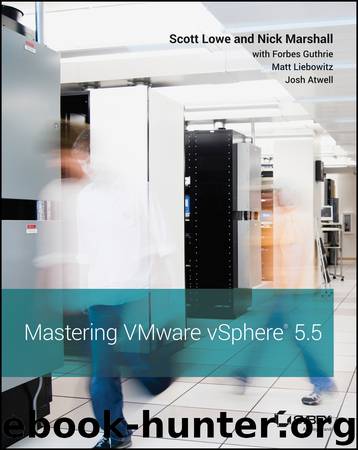Mastering VMware vSphere 5.5 by Scott Lowe & Nick Marshall & Forbes Guthrie & Matt Liebowitz & Josh Atwell

Author:Scott Lowe & Nick Marshall & Forbes Guthrie & Matt Liebowitz & Josh Atwell
Language: eng
Format: epub
Publisher: John Wiley & Sons
Published: 2013-03-30T04:00:00+00:00
After reviewing the diagram of a cluster-in-a-box configuration, you might wonder why you would want to deploy such a thing. The truth is, you would want to deploy a cluster-in-a-box configuration only in certain circumstances because it still maintains a single point of failure. With both VMs running on the same host, if that host fails, both VMs fail. This architecture contradicts the very reason for creating failover clusters. A cluster-in-a-box configuration still contains a single point of failure that can result in downtime of the clustered application. If the ESXi host hosting the two-node cluster-in-a-box configuration fails, then both nodes are lost, and a failover does not occur. It's a relatively simple setup to configure and probably best suited for learning or testing the cluster service configurations. You may also find yourself in a situation where it's needed for planned downtime or patching.
Configuration Options for Virtual Clustering
As suggested in the first part of this chapter, server clusters are deployed for high availability. In a vSphere-based outage, high availability is not achieved by using a cluster-in-a-box configuration, and therefore you should avoid this configuration for any type of critical production applications and services.
Download
This site does not store any files on its server. We only index and link to content provided by other sites. Please contact the content providers to delete copyright contents if any and email us, we'll remove relevant links or contents immediately.
Test-Driven iOS Development with Swift 4 by Dominik Hauser(7900)
Filmora Efficient Editing by Alexander Zacharias(6566)
The Infinite Retina by Robert Scoble Irena Cronin(6069)
Learn Wireshark - Fundamentals of Wireshark. by Lisa Bock(4392)
Linux Device Driver Development Cookbook by Rodolfo Giometti(4010)
Edit Like a Pro with iMovie by Regit(3825)
Linux Administration Best Practices by Scott Alan Miller(2927)
Linux Command Line and Shell Scripting Techniques by Vedran Dakic & Jasmin Redzepagic(2885)
Mastering PowerShell Scripting - Fourth Edition by Chris Dent(2783)
Creative Projects for Rust Programmers by Carlo Milanesi(2616)
MCSA Windows Server 2016 Study Guide: Exam 70-740 by William Panek(2570)
Docker on Windows by Stoneman Elton(2362)
Kali Linux - An Ethical Hacker's Cookbook: End-to-end penetration testing solutions by Sharma Himanshu(2351)
Hands-On AWS Penetration Testing with Kali Linux by Karl Gilbert(2189)
Hands-On Linux for Architects by Denis Salamanca(2119)
Computers For Seniors For Dummies by Nancy C. Muir(2094)
Programming in C (4th Edition) (Developer's Library) by Stephen G. Kochan(2081)
The Old New Thing by Raymond Chen(2035)
Linux Kernel Debugging by Kaiwan N Billimoria(1812)
